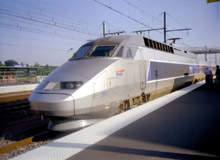
France has no intention of shedding its reputation as the world leader in high-speed railways.
It smashed the record in April 2007, achieving 574.8km/h on a special demonstration run.

Discover B2B Marketing That Performs
Combine business intelligence and editorial excellence to reach engaged professionals across 36 leading media platforms.
While this is an extreme, the realistic target of 350km/h now looks achievable with infrastructure existing in the shape of the LGV Est.
The 300km route stretching east from the Paris suburbs is already doing great business, and there is another 100km to Strasbourg planned.
The French are hungry for greater high-speed successes, and to assume the European benchmark 300km/h will stay as the operational limit is akin to announcing the end of railway history.
RAIL FIGHTS BACK

US Tariffs are shifting - will you react or anticipate?
Don’t let policy changes catch you off guard. Stay proactive with real-time data and expert analysis.
By GlobalDataTo sustain the ‘Greater Europe’ economic entity, journey times between European capitals have to shrink and rail is seen as the eco-friendly way ahead in preference to carbon-unfriendly air travel.
The Franco-Swiss Lyria TGV operation is already biting chunks out of the market share formerly held by airlines on routes such as Zurich-Basle-Paris, while the Eurostar is doing the equivalent, thanks to the speed-up of London-Paris-Brussels services via the Channel Tunnel.
It is hard to believe that Alstom would have produced its new high-tech AGV train with a service speed of 360km/h if it wasn’t confident that sufficient lines would exist to find customers.
Speed costs, however. The French would be moving a lot faster in building more routes, but the days are gone when local politicians would battle for inclusion on an LGV alignment.
Mindful of the scant services at token stations, fearful of the noise and visual scarring, plus growing unease at the power drawn by high-speed trains, the unalloyed welcome in the early years has gone into retreat.
So if ever-faster steel wheel on steel rail is not practicable, what are the alternatives?
With fuel prices soaring and pressure to reduce technical performance and impose punishing speed limits, the perceived advantages of high-speed rail over road for longer journeys seem certain to grow.
The speed of jet airliner operation has not significantly changed since fleets first took to the air in the 1950s. The massive growth in air travel in the early 21st century is not down to speed, but simply because it became so cheap. Although for many routes air is literally the only way to go, France is not one of those situations.
FRENCH FUTURE
France seems almost designed for modern rail technology, with its population centres so well placed. While it may be expensive to create, noisy and costly in operation, high-speed rail is in ‘green’ terms now widely regarded as preferable to flying.
The format has prospered and spread, so much so that a second LGV route from the capital to Lyon appears likely.
While neighbouring Germany has toyed with the magnetic Maglev, a doubling of costs has seen politicians wary of sinking more taxpayers’ money into the project. The Maglev was predicted to be in use by now and while it has proved itself a great workable idea in Shanghai, one of the few places where there is one in public service, the Maglev looks ever less feasible.
To put it simply, speed developments are back, with steel wheels running on steel rails. France has let the high-speed genie out of the bottle but the trick is not to squander the benefits it can deliver.





